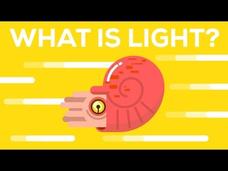SciShow
Some Of You Can See The Invisible
We know that not everyone's vision is perfect, which is why some of us need glasses. But some people can also just see more stuff than others! From seeing UV and infrared light, to even having bonus color receptors in our eyes, there are...
Curated Video
Illuminating Innovations: Harnessing Natural Light in Urban Spaces
Discover how innovative technologies are revolutionizing the way we light our homes and workplaces without relying on electricity. This documentary explores the use of light tubes, fiber optics, and even bioluminescent plants to enhance...
Physics Girl
Electric Charge and Light - Physics 101 / AP Physics 1 Review with Dianna Cowern
Lesson 18 (Electric Charge and Light) of Dianna's Intro Physics Class on Physics Girl. Never taken physics before? Want to learn the basics of physics? Need a review of AP Physics concepts before the exam? This course is for you!...
Curated Video
The Language of Color
This video explores how the perception of color varies among individuals and cultures. It highlights the influence of language and cultural associations on our interpretation of colors. By examining different languages and their unique...
Curated Video
Understanding Color Blindness
This video provides an explanation of color blindness, also known as color vision deficiency. It discusses the causes, types, and effects of color blindness. Colors part 7/9
NASA
NASA | MicroSpec: Revolutionary Instrument on a Chip
Scientists may finally get a glimpse at our adolescent universe from a revolutionary new technology being developed at NASA's Goddard Space Flight Center. An instrument on a chip. This new, potentially game-changing instrument, called...
Curated Video
Introduction to Germanium: Properties and Applications
This video provides an overview of the element germanium. It describes the physical properties of germanium and its discovery by Clemens Winkler. The video also discusses the various uses of germanium, such as in semiconductors, optical...
Scholastic
Study Jams! Light
Let there be light in your classroom with a video that explains that light travels in waves, the electromagnetic spectrum contains seven colors, and the color of an object depends on which light waves it reflects and absorbs. With...
Physics Girl
How Rainbows Form
Somewhere over the rainbow ... the sky appears to be darker than below it? Why is that? A video from an interesting physics playlist illustrates the interaction between the visible spectrum and droplets of rain. It also doubles the...
Physics Girl
Seeing the Smallest Thing in the Universe
How do we see what we can't see? An episode of a comprehensive physics playlist shows images of the smallest particles current technology can record. The instructor discusses current and past research on the makeup of subatomic particles.
Physics Girl
Does This Look White to You?
Explore the difference between the two color wheels. The focus of the installment of a larger physics playlist is to explain the difference between mixing colored paints and colored lights. Viewers find that the components of their eyes...
American Chemical Society
The Chemistry of Fireworks
Experiment with chemical compounds to produce the colors in fireworks! The lesson instructor demonstrates how adding high temperatures to specific compounds creates a colorful reaction—the same one people use to create fireworks. This is...
Kurzgesagt – In a Nutshell
What Is Light?
Why is light like the Navy? Because they both travel at c. The video explains what light is and what makes visible light different from the rest of the light spectrum. Scholars finish the video enLIGHTened about the concept.
Crash Course
Telescopes
According to the video, astronomy is like a jigsaw puzzle with an infinite number of pieces. The video explains the history and invention of telescopes, how they work, refraction versus reflection, and the changing technology. It...
MinutePhysics
This is Not a Rainbow
A color-based video explains how scientists identified the colors of the rainbow and why we see different colors at different times. It introduces the idea of supernumerary colors and the disc shape of a rainbow as well.
MinutePhysics
Why is the Sun Yellow and the Sky Blue?
Air is clear, so why do we see the sky as blue? The video explains the way light waves travel through the air and the result of our perceptions. It uses simple diagrams and illustrations to reinforce the variety of colors present versus...
MinutePhysics
The Origin of Quantum Mechanics (feat. Neil Turok)
How do you get the most light out of a light bulb? That's the task Max Planck took on, and it turned out to be rather...enlightening! The illustrated video introduces physics scholars to Planck's plight, which ultimately changed our...
MinutePhysics
There is No Pink Light
Barbie, pink flowers, Pink Panther, pink pigs, pink clothes, and pink flamingos all have one thing in common — they really aren't pink because there is no such thing as pink light. So, what is the color we call pink? The short video...
MinutePhysics
Tutorial: Creating the Sound of Hydrogen
How do you create the sound of hydrogen? An interesting video explains how to use mathematical formulas and sound software to translate the spectrum of light that comes from hydrogen into a sound. The resource walks through each...
TED-Ed
Does This Look White to You?
Believe it or not, the light color wheel and the paint color wheel are not the same. Physics Girl explains how computer screens trick viewers into seeing colors that are not actually present (Hint: It's cones versus wavelengths).
Curated OER
STEMbite: Diffraction
This psychedelic session of STEMbite introduces the concept of diffraction to your upper elementary science class. The teacher in the video uses a compact disc to show the rainbow results of the bending of light and then dons a pair of...
Curated OER
Red Shift: Measuring Distance in Space
Learn about gamma rays and red shift, what they are, what they mean, and how scientists use them to measure distances between objects in space. This clip explains how important red shifted gamma rays are to science and how illusive they...














